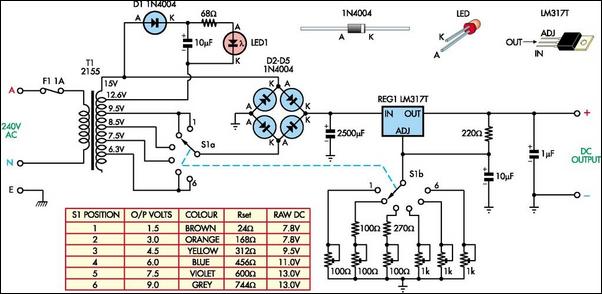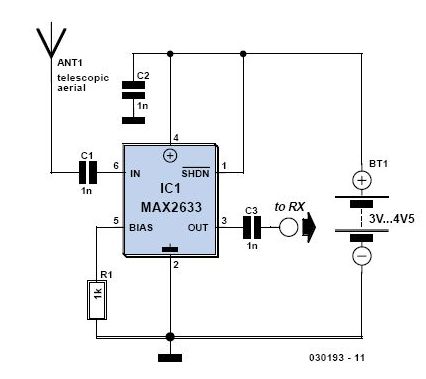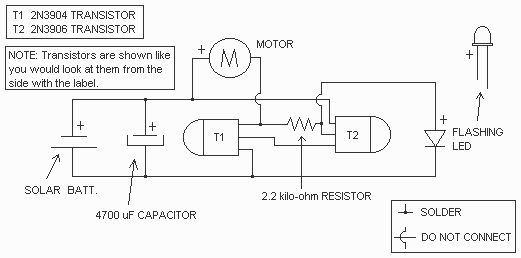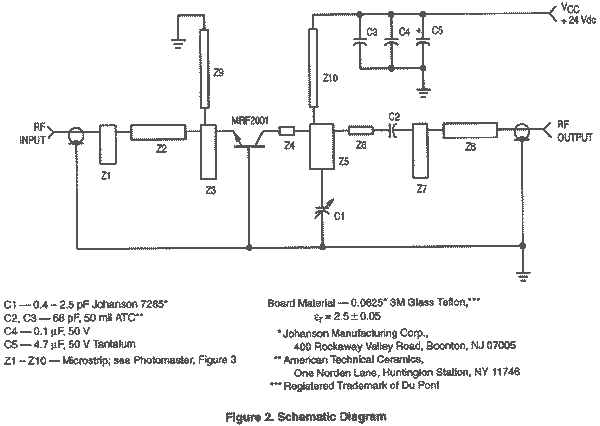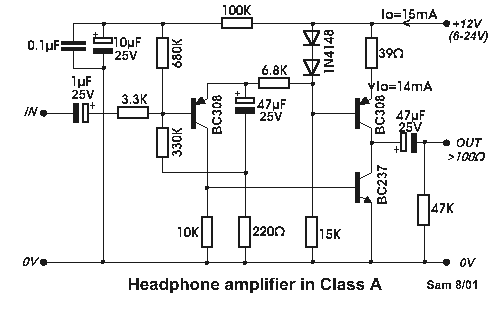
55W (Originally 75W) Power Amplifier
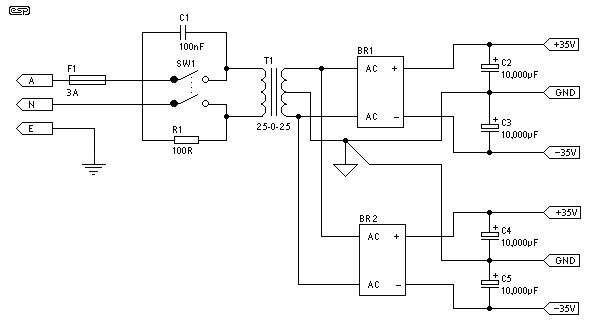
To order boards, click to access the ESP Purchase form. Verify the price and postage, then open the order form, fill it in, and print it from your browser. Boards are sold only as a stereo pair and are supplied with a component overlay, circuit diagram, bill of materials, and assembly and test instructions. These instructions are provided as an HTML file on a floppy disk. Complete kits for this amplifier are currently available from the Printed Electronics website. For those who prefer not to source all the components from various suppliers, this is a convenient option. Details and pricing are available from Printed Electronics, as they may change over time. According to the latest information on the Printed Electronics website, the amplifier has been downgraded to 55W, which is still sufficient power for most loudspeakers. The maximum recommended supply voltage is ±35V, and it is advised not to exceed this (the amplifier was previously stated to use a ±42V supply voltage). The drawings have been updated to reflect this change. It was developed to address many sonic issues associated with transistor amplifiers and incorporates innovative design elements. It provides excellent resolution and a pure sound at a low cost. Both channels are assembled on individual 86mm x 75mm boards and mounted on a single 300 x 75 mm ledged heatsink. The amplifier operates efficiently in Class AB, powered by a dual 35V supply. Notably, it exhibits minimal intermodulation and impressive stereo imaging, which is uncommon for solid-state amplifiers. For optimal performance, a dual mono power supply is recommended, and a schematic is provided with the boards. The boards are designed to allow for an upgrade to 100W per channel (into 4 ohms) with minor component changes and the addition of an extra pair of output transistors per channel. The circuit diagram for the amplifier is depicted in Figure 1. It is a relatively straightforward design, with all components (excluding the power supply) fitting onto a single board. It should be noted that the schematic shown is conceptual only, as per the designer's request, to protect the design from potential piracy due to its exceptional performance. A complete schematic with all component values and assembly instructions is included with the circuit boards. Typically, all ESP projects include complete schematics, but this design is not the intellectual property of the writer and will be protected accordingly. The potentiometer (P1) is used to set the quiescent current, typically adjusted to 100mA. Instead of a bias servo, diodes D2 and D3 (1N4148 types) are mounted in contact with the main heatsink. These must be insulated and secured with Superglue to ensure good thermal contact. Power should be applied (preferably with 22-ohm safety resistors in series with the positive and negative supply lines) with the potentiometer P1 set to minimum resistance, and no speaker connected at this time. It is essential to check for heating of any components and ensure that the output voltage is below 1 Volt. To adjust the bias current, reinstall the fuses, do not connect a speaker, and apply power. After a few minutes for the amplifier to stabilize, measure the voltage across one of the 0.47-ohm output emitter resistors. Carefully adjust P1 until a voltage of 47mV is read, which corresponds to 100mA. Verify that the output voltage remains within approximately 100mV. After several minutes, check the quiescent current again and make adjustments as necessary. WARNING: Mains wiring must be performed by a qualified electrician. Do not attempt the power supply unless suitably qualified, as faulty mains wiring may result in death or serious injury. The amplifier can operate as a stereo pair from a single supply, as illustrated in Figure 2. Depending on the requirements, this configuration may be adequate. Note the capacitor and resistor (R1 and C1) across the mains switch. The capacitor must be rated for at least the full AC supply voltage (i.e., 120V or 240V AC), and all wiring (including the 100-ohm resistor) should be well insulated to prevent accidental contact with the chassis or fingers. Please refer to the disclaimer for further warnings regarding mains wiring. An improved solution is to utilize a dual-mono supply, which shares one transformer but employs two bridge rectifiers and two sets of filter capacitors. This design minimizes interaction between the amplifiers, as depicted in Figure 3. This supply is nearly identical to the one presented in Project 04, except for the voltage. Two additional differences can be observed when comparing the two: the original supply includes an inbuilt earth-loop breaker circuit, while this one has an RC snubber circuit across the mains switch. Either feature can be incorporated into either power supply as needed. For both supplies, a 300VA transformer and 35A bridge rectifiers are recommended for optimal regulation. In regions using 115V, a 6A fuse (F1) is advisable, and a slow-blow fuse is necessary due to the inrush current of the transformer. Similar to the supply in Project 04, the supply voltage may exceed the quoted value at no load and decrease under full load, which is typical behavior and attributed to transformer regulation. For further information on this matter, refer to Project 4. In certain instances, achieving the rated power may not be feasible if the transformer is inadequately rated.To order boards, click to go to the ESP Purchase form. Verify the price and postage, then open the order form, fill it in and print it from your browser. Boards are sold only as a stereo pair, and are supplied with component overlay, circuit diagram, bill of materials and assembly and test instructions. These instructions are as an HTML file on fl oppy disk. Complete kits for this amplifier are available now from the Printed Electronics web site. For those who do not want to have to scrounge all the component suppliers to get the parts, this is definitely the way to go. Details and all pricing are available from Printed Electronics as these may change over time I shall not reproduce them here.
According to the latest information on the Printed Electronics web site, the amp has been downgraded to 55W, which is still more than enough power for all but the most inefficient loudspeakers. The maximum recommended supply voltage is +/-35V, and it is recommended that this is not exceeded (the amp was previously stated to use a +/-42V supply voltage).
The drawings below have been duly amended to reflect this change. It was developed to overcome most of the sonic problems of transistor amplifiers, and incorporates some highly innovative thinking from an experienced designer. It delivers stunning resolution and a pure, sweet sound at very low cost. Both channels are assembled on their own individual 86mm x 75mm boards and mounted on a single 300 x 75 mm ledged heatsink.
It is powered from a 35 volt positive and negative supply, and runs very efficiently in Class AB. Features of this amplifier are its lack of intermodulation and depth of stereo image, unusual for a solid state amplifier. To achieve the best performance, a dual mono power supply is required a schematic is supplied with the boards.
To cap it off, the boards are designed so that it can be built up to 100W per channel (into 4 ohms) with only minor changes to various components and the addition of an extra pair of output transistors on each channel. The circuit diagram for the amp is shown in Figure 1. As can be seen, it is not a complicated amplifier, and all components (excluding power supply) fit onto a single board.
Please Note The schematic shown is conceptual only, at the request of the designer. This has been done to protect the design from possible piracy, due to the extremely good performance from what is (or appears to be) a simple circuit. A full schematic with all component values and assembly instructions is available with the circuit boards.
Normally all ESP projects have complete schematics, but this is not my intellectual property and I will always protect the interests of my contributors. * The pot (P1) is used to set quiescent current. This will normally be adjusted to 100mA. No bias servo is used instead, the diodes D2 and D3 (1N4148 types) are mounted so that they are in contact with the main heatsink.
These must have their leads insulated and be secured using Superglue to ensure good thermal contact. Apply power (preferably with 22 ohm safety resistors installed in series with the +ve and -ve supply lines) with the pot P1 at minimum resistance do NOT connect a speaker at this time. Check for heating of any components, and ensure that the voltage at the output is less than 1 Volt. To adjust the bias current, reinstall the fuses, do not connect a speaker and apply power. Wait for a few minutes for the amp to stabilise, then measure the voltage across one of the 0. 47 ohm output emitter resistors. Carefully adjust P1 when you read a voltage of 47mV, this equates to 100mA. Verify that the output voltage is within about 100mV. After a few minutes (checking for heat in the meantime), check the quiescent current again, and adjust as needed.
WARNING:Mains wiring must be performed by a qualified electrician Do not attempt the power supply unless suitably qualified. Faulty mains wiring may result in death or serious injury. The amp can be operated as a stereo pair form a single supply as shown in Figure 2. Depending on your needs, this will often be quite adequate. Note the capacitor and resistor (R1 and C1) across the mains switch. The capacitor must be rated for at least the full AC supply voltage (i. e. 120V or 240V AC), and all wiring (including the 100 ohm resistor) should be well insulated to prevent accidental contact to the chassis or a finger.
Please read the disclaimer for further suitable warnings about mains wiring. A better solution is to use a dual-mono supply. This shares one transformer, but uses two bridge rectifiers and two sets of filter capacitors. This arrangement minimises any interaction between the amps, and is shown in Figure 3. This supply is virtually identical to the one I presented as Project 04 except for the voltage. Two other differences will be seen if the two are compared My original supply has an inbuilt earth-loop breaker circuit, and this one has an RC snubber circuit across the mains switch. Either of these can be applied on either power supply as required. For both supplies, I suggest a 300VA transformer and 35A bridge rectifiers for best regulation. For 115V countries, the fuse (F1) should be 6A, and in all cases a slow blow fuse is required because of the inrush current of the transformer.
Like the supply in Project 04, the supply voltage can be expected to be higher than that quoted at no load, and less at full load. This is entirely normal, and is due to the regulation of the transformer. For more information on this topic, see Project 4. In some cases, it will not be possible to obtain the rated power if the transformer is not adequately rated.
🔗 External reference
According to the latest information on the Printed Electronics web site, the amp has been downgraded to 55W, which is still more than enough power for all but the most inefficient loudspeakers. The maximum recommended supply voltage is +/-35V, and it is recommended that this is not exceeded (the amp was previously stated to use a +/-42V supply voltage).
The drawings below have been duly amended to reflect this change. It was developed to overcome most of the sonic problems of transistor amplifiers, and incorporates some highly innovative thinking from an experienced designer. It delivers stunning resolution and a pure, sweet sound at very low cost. Both channels are assembled on their own individual 86mm x 75mm boards and mounted on a single 300 x 75 mm ledged heatsink.
It is powered from a 35 volt positive and negative supply, and runs very efficiently in Class AB. Features of this amplifier are its lack of intermodulation and depth of stereo image, unusual for a solid state amplifier. To achieve the best performance, a dual mono power supply is required a schematic is supplied with the boards.
To cap it off, the boards are designed so that it can be built up to 100W per channel (into 4 ohms) with only minor changes to various components and the addition of an extra pair of output transistors on each channel. The circuit diagram for the amp is shown in Figure 1. As can be seen, it is not a complicated amplifier, and all components (excluding power supply) fit onto a single board.
Please Note The schematic shown is conceptual only, at the request of the designer. This has been done to protect the design from possible piracy, due to the extremely good performance from what is (or appears to be) a simple circuit. A full schematic with all component values and assembly instructions is available with the circuit boards.
Normally all ESP projects have complete schematics, but this is not my intellectual property and I will always protect the interests of my contributors. * The pot (P1) is used to set quiescent current. This will normally be adjusted to 100mA. No bias servo is used instead, the diodes D2 and D3 (1N4148 types) are mounted so that they are in contact with the main heatsink.
These must have their leads insulated and be secured using Superglue to ensure good thermal contact. Apply power (preferably with 22 ohm safety resistors installed in series with the +ve and -ve supply lines) with the pot P1 at minimum resistance do NOT connect a speaker at this time. Check for heating of any components, and ensure that the voltage at the output is less than 1 Volt. To adjust the bias current, reinstall the fuses, do not connect a speaker and apply power. Wait for a few minutes for the amp to stabilise, then measure the voltage across one of the 0. 47 ohm output emitter resistors. Carefully adjust P1 when you read a voltage of 47mV, this equates to 100mA. Verify that the output voltage is within about 100mV. After a few minutes (checking for heat in the meantime), check the quiescent current again, and adjust as needed.
WARNING:Mains wiring must be performed by a qualified electrician Do not attempt the power supply unless suitably qualified. Faulty mains wiring may result in death or serious injury. The amp can be operated as a stereo pair form a single supply as shown in Figure 2. Depending on your needs, this will often be quite adequate. Note the capacitor and resistor (R1 and C1) across the mains switch. The capacitor must be rated for at least the full AC supply voltage (i. e. 120V or 240V AC), and all wiring (including the 100 ohm resistor) should be well insulated to prevent accidental contact to the chassis or a finger.
Please read the disclaimer for further suitable warnings about mains wiring. A better solution is to use a dual-mono supply. This shares one transformer, but uses two bridge rectifiers and two sets of filter capacitors. This arrangement minimises any interaction between the amps, and is shown in Figure 3. This supply is virtually identical to the one I presented as Project 04 except for the voltage. Two other differences will be seen if the two are compared My original supply has an inbuilt earth-loop breaker circuit, and this one has an RC snubber circuit across the mains switch. Either of these can be applied on either power supply as required. For both supplies, I suggest a 300VA transformer and 35A bridge rectifiers for best regulation. For 115V countries, the fuse (F1) should be 6A, and in all cases a slow blow fuse is required because of the inrush current of the transformer.
Like the supply in Project 04, the supply voltage can be expected to be higher than that quoted at no load, and less at full load. This is entirely normal, and is due to the regulation of the transformer. For more information on this topic, see Project 4. In some cases, it will not be possible to obtain the rated power if the transformer is not adequately rated.
🔗 External reference
